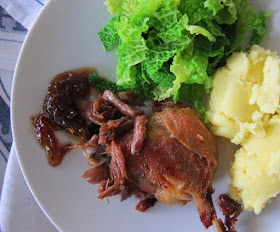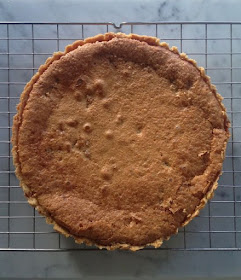 |
| Confit Duck Leg |
Occasionally, when roast duck is decided upon I claim the legs. A disappointment to some until "confit" is mentioned. If you have a good plump duck it roasts perfectly well without the legs and gives you the opportunity to make one of my favourite dishes in the world - Confit Duck.
Both Simon Hopkinson and Nigel Slater have recipes for roast duck stuffed with potatoes and onion. I have yet to try the Hopkinson version, but have cooked the Slater recipe several times with great success. The one time it didn't work out, the fault lay entirely with the quality of the duck. Pre-ordered and ticked-off the shopping list, I collected it, trustingly, unseen. A more malnourished bird it would be impossible to imagine. Other times, the dish has been astonishingly good with tender, juicy meat and crisp skin, achieved by adopting the Chinese way in its preparation. The potato and onion stuffing emerges fragranced with bay and rosemary and rich with rendered duck fat. The last few spoonfuls scraped from the cavity are sublime pan-fried the following day. I only wish I could give you a link to that recipe but although you can find Slater's Roast Duck with pancetta and potatoes on-line, the recipe I use is an earlier one. It appears in Real Food first published in 1998.
Roasting a duck leaves you with a good quantity of leftover fat for cooking the duck legs. The word confit comes from the Latin conficere, meaning simply 'to do', 'to make', 'to produce'. In Medieval times the French applied their verb confire to fruits cooked and preserved in sugar syrup or honey or even alcohol. Later it was used to describe vegetables, meats and other foods preserved in oil, fat or salt. Ancient civilisations are known to have preserved cooked meats under a seal of fat. Today we generally use the word confit to describe something cooked slowly and gently until it is soft and succulent and not necessarily with the intention of long keeping. That's a shame because the flavour does develop with storing. Confit duck, or perhaps pork belly, are foods that immediately come to mind, but it's a good long and slow method for any meats with a lot of connective tissue. It renders the meat silky soft and luscious.
 |
| Duck legs after marinating |
Duck confit is incredibly easy and, given the cost of those sold in jars or vac-packed, well worth preparing yourself. Once you've gone through the first 2 steps the meat will keep in the fridge for several weeks so long as you make sure it's completely covered in the fat. Simon Hopkinson suggests at least 3-4 weeks and as much as 3-4 months. Mine have never lasted more than 2 weeks before my resolve has cracked and I just couldn't resist a moment longer. You don't have to restrict yourself to the legs but their fatty plumpness gives the best result.
I use either rosemary or thyme to flavour the flesh, sometimes both, depending on what I have, but bay leaf is a must. I don't tend to worry too much about proportions but I turned to Simon Hopkinson's 'Second helpings of roast chicken' to bring some precision to the mix.
Confit Duck Legs
(serves 2)
2 plump duck legs
2 tablespoons of good salt
2 teaspoons of sugar
1 bay leaf
3-4 sprigs of thyme or a 5cm branch of rosemary
4-5 black peppercorns
A grating of nutmeg
350ml duck or goose fat
3 cloves of garlic, unpeeled but bruised
Step 1:
Briefly pound in a pestle and mortar or just mix together the salt, sugar, herbs and spices. Pour half of the mixture into a shallow dish, add the duck legs, flesh side down, and pour the remaining mixture on top. Cover and refrigerate for 24 hours, turning the legs once.
Step 2:
Preheat the oven to 130C/Fan oven 110C/Gas 1
Dry the duck legs throughly with kitchen paper, removing any herbs/spices.
Melt the duck or goose fat in a solid cast-iron pot over a low heat. Add the duck legs and the garlic, bring to a simmer, then transfer the pot to the oven. Cook for around 2 hours until the meat is soft and yielding to a skewer.
Once cool, place the duck legs in a clean glass or ceramic dish (or a sterilised jar if you plan to keep them for more than 2-3 weeks), completely cover with the fat and refrigerate.
 | |
|
Remove the duck legs leaving behind as much of the fat as possible. To enjoy them as I've shown above, heat a frying pan on a moderate heat and fry the duck legs skin side down for about 10 minutes until the skin is crisp, then turn and fry for 10 minutes more to ensure they are thoroughly re-heated.
Plain mashed potatoes and Savoy cabbage are perfect to balance out the richness of the duck. A spoonful of onion marmalade provides a good sweet/sour counterpoint. Alternatively, they are delicious served with Puy lentils and peppery watercress.


